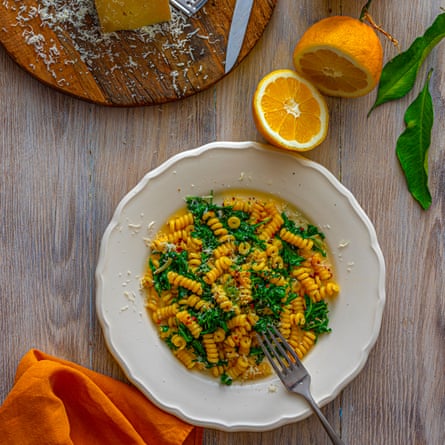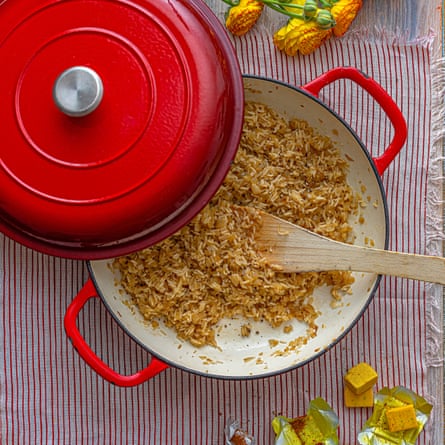
Melek Erdal’s jazzed-up beans on toast (pictured above)
Whenever I have friends round, it doesn’t matter what time, we make breakfasty food. It’s a bit like breaking the rules, but also feels comforting. This is a recipe that came out of lockdown, the most intense part where we were barely allowed to go out.
We shopped about every three weeks. The limitations were an amazing time for creativity. There’s a saying in Middle East households that it’s a blessing to use everything you have, that you’re bringing fortune into your home. One day, we didn’t have much left and my housemate at the time added spices she liked and onions, ginger and garlic to baked beans. She said it was quite a Somali thing to do. She thought it was nothing. I thought it was amazing.
I made my version, adding Turkish peppers and my own kind of spices – and we just kept making it for each other back and forth, jazzing up beans. It was comforting, but so good – and good for you.
It’s not meant to be fancy. The flavour of baked beans, the sweetness and the consistency, really make the recipe – you couldn’t do this as well with any other kind of bean. I’ve never felt more British than when I cook beans on toast for people. My housemate’s family is from Somalia and mine is Kurdish, and this recipe is what British means to us. Baked beans have infiltrated us, but we’ve infiltrated them back.
Serves 1
coriander seeds 1 tsp
cumin seeds 2 tsp
turmeric ½ tsp
aleppo chilli flakes a pinch
olive oil 4 tbsp
red onion 1
garlic 2 cloves
red chilli ½
ginger 10g
salt and pepper
baked beans ½ x 400g tin
free-range organic egg 1, from the happiest chicken you know
bread of your choice (I love rye for this recipe)
fresh coriander a handful
lemon or lime to serve (optional)
Fry all the spices in the olive oil on a medium heat for 1 minute.
Finely chop the red onion, garlic, fresh chilli and ginger and add it to the spices. Fry until softened and caramelised (about 10 minutes).
Add the baked beans, stir thoroughly and leave to simmer for a further 5 minutes on a low heat.
While your beans are simmering, fry the egg in a separate pan and toast your bread.
Serve all together and top with some fresh coriander and maybe a wedge of lemon or lime.
Melek Erdal is a food writer and a regular guest on Radio 4’s The Kitchen Cabinet
Georgina Hayden’s strapatsada
Growing up, this kind of dish would always be on the side in both of my grandmothers’ kitchens, and it’s what my mum would make on a Saturday afternoon, or for a lazy weeknight when there wasn’t much in the house. She would make it with tinned tomatoes, because they’re versatile and cheap, and she and my sister love it. I never really did until I got older and made it with fresh tomatoes, which I have on my counter even in the depths of winter.
I grate and cook them down till they’re sweet, adding a few flavours – garlic, paprika, a bit of chilli, depending on who I’m cooking it for – before rippling in eggs right at the end. It doesn’t sound like much but it’s amazing. It’s also really versatile. This is a recipe for four, but it scales up or down really well – divide the tomatoes and eggs and play loose with the rest as you like. Got no onion, or too much onion? Fine. Add a tablespoon of tomato puree for richness; crumble over feta instead of halloumi.
I make it quickly for my daughters after school, but also will do it as part of a lazy brunch spread if friends or family come round at the weekend. You can eat it hot or at room temperature. Strapatsada is the Greek word – my Cypriot family would call this ntomata me avga, which really just means tomatoes with egg. It’s a really simple way to cook any vegetable you have – instead of the tomato, try asparagus in the spring, or courgette in the summer.
Serves 4
ripe tomatoes 800g
olive oil 2 tbsp
butter a large knob
onion 1, peeled and finely chopped
garlic 2 cloves, peeled and finely chopped
sweet smoked paprika a big pinch
caster sugar 1 tsp
red wine vinegar ½ tbsp
dried oregano 1 tsp
sea salt and freshly ground black pepper
free-range eggs 8 large
halloumi 75g
toast or pitta bread to serve
Grate the tomatoes on a coarse grater, discarding the skins. Heat the oil and butter in a large non-stick frying pan over a medium-low heat and add the onion and garlic. Fry for 10 minutes, until it starts to soften and become sticky.
Stir in the paprika, sugar, vinegar and most of the dried oregano (reserve a large pinch). Fry for another minute, then add the chopped or grated tomatoes, and season well with salt and pepper. Gently bring to the boil, reduce the heat just a little, then leave to cook for about 15 minutes. Most of the liquid needs to have evaporated and the tomatoes should start to gently caramelise.
Crack the eggs into a bowl and season with salt and pepper. Beat and then pour into the pan with the tomatoes. Lower the heat a little more and scramble the eggs and tomatoes together. Keep stirring and cooking over a low heat. When the eggs are half cooked, remove from the heat. Keep stirring off the heat until the eggs are creamy and silky. Sprinkle with the remaining oregano and coarsely grate over the halloumi. Serve with toast or pitta.
Georgina Hayden is a food writer and broadcaster. Her latest book is Nistisima (Bloomsbury, £26)
Georgia Levy’s lemon, parmesan and rocket pasta

This is a dish for one of those days where you’ve been very busy, or very stressed, or you just need the comfort of pasta, but you don’t want to spend ages standing over your sauce, stirring, buying mince, waiting for your tomatoes to cook down. You need pasta and you need it now. You want the rocket in there for the crunch and to have a vegetable element, a touch of green.
You can play pretty loose with the amounts – I sometimes add an extra handful of parmesan if it’s been a really bad day. And you can adapt it to whatever you have around – chopped asparagus can go in with the garlic, or broccoli, perhaps grated courgette. Really, anything you have in your fridge can be thrown in there. I often have ricotta in mine, so a couple of tablespoons stirred in at the end adds creaminess, but not in a sickly way.
There’s a kind of magic that happens when you combine oil, lemon juice and pasta water – it wraps round the pasta to bring all the elements together. It’s something you can do with ingredients through the seasons, so you don’t have that separation between pasta and sauce. The secret is to let everything meet over a low heat – bizarre things happen to parmesan if it gets too hot.
When writing recipes, I always find it hard to specify how much pasta to cook, because if it’s for me, I probably double it. I can definitely smash three-quarters of a bag. Pasta is always there for you.
Serves 1
fusilli 100-125g or any other pasta
olive oil 2 tbsp
garlic 1 small clove, finely sliced
dried chilli flakes a pinch, plus extra to serve
lemon juice a squeeze
parmesan or pecorino 25g, finely grated
rocket 1 x 60g bag, roughly chopped
Bring a pan of salted water to the boil and cook your pasta to just shy of al dente.
Meanwhile, warm the oil in a wide frying pan (that can hold the pasta) over a medium-low heat and gently fry the garlic until it begins to feel sticky and is slightly golden on the edges. Add the chilli flakes, wait a second for them to warm through, then squeeze in the lemon juice.
Add 1-2 tablespoons of pasta cooking water and half the cheese – you want it finely grated so it just melts away. Making sure the heat isn’t too high, stir until the cheese has just melted and you have a sauce. Take off the heat if the pasta isn’t ready yet.
As soon as the pasta is cooked, drain it, reserving a cup of the cooking liquid. Turn the heat up to medium and add the pasta to the sauce, stirring constantly for 2-3 minutes until every piece is coated. It should be nice and wet, add more cooking water if not.
Take off the heat and fold in the remaining cheese and rocket. Don’t be shocked by the amount of rocket, it cooks down dramatically and adds a great peppery flavour. Season with pepper (and salt if it needs it) and carefully fold until the cheese has melted. I like it when the rocket still has a bit of crunch. Transfer to plates, sprinkle with a little extra chilli and serve.
Georgia Levy is a food writer and recipe developer. Her latest book is Let’s Do Lunch (Pavillion, £16.99)
Itamar Srulovich’s onion rice

My go-to simple comfort meal is Nigella’s Marmite pasta. But my wife doesn’t love it so much. So, when we’re together, we make onion rice, and its derivative, tuna rice. It’s so simple, but the most delicious thing.
My stepfather used to make it every Friday. Friday night is a big deal in Israel. In old-school families, you’re not allowed to cook on Saturdays, so on Friday, until about 2pm everybody cooks the food for the weekend. Even though my family was not religious, we still cooked for a Friday night dinner. Onion rice was non-negotiable – it would be the first thing we ate for a late lunch on Friday.
Onion rice is not a side, it’s a dish on its own, and it’s a ceremony – a very pure moment. It is basically onions cooked in butter, or margarine is even better. You have to use chicken stock cubes of the cheapest variety – the bright yellow ones. It’s the only recipe where I’d use no other spice than black pepper. This is the starting point. Sometimes we’ll riff on it, and fold in tuna at the end. This version is called dirty onion rice. That’s the trinity.
You can add other things, but there are rules. You can add carrot and celery to the onion but they must be chopped the same size. On rare occasions tinned tomatoes can go in, but you need to change the water ratio, which is why we don’t often do it. Tomato puree is sometimes a welcome addition. Spinach or a parmesan rind, or fresh cheese with the tuna. Sometimes you don’t know what is right, but you will know if it’s wrong. The thought of adding spice makes me recoil in my heart. There is something very comforting about having food rules.
Serves 2
chicken stock cubes 2 (homemade stock will produce inferior results)
butter or vegetable oil 1 tbsp
onions 2 large, chopped but not too fine
long grain rice 210g (1 x 250ml cup)
Boil a kettle, measure 375ml of water and dissolve the stock cubes.
In a large, shallow pan, heat the fat and onion on a low heat and saute until soft and translucent – do not let it colour.
Add the rice to the pan and saute until all the grains are nice and glossy. Add your stock and a good shake of black pepper. Taste – different brands of stock have different levels of salt; the liquid should be powerfully salty but not unpleasantly so. If it isn’t, add a pinch of salt.
Bring to the boil. Once boiling, stir the rice, lower the heat to a gentle simmer and cover the pan with a tight fitting lid for exactly 10 minutes – put a timer on.
When the timer beeps, take off the heat but do not remove the lid – set another 10 minutes on the timer and leave to steam with the lid on.
After 10 minutes, remove the lid – the rice should be fully cooked and fragrant, the onion soft, translucent and jelly-like, forming a ring around the edge of the pot. Gently stir it in with the rice and serve.
Onion rice is a moment of simple pleasure. Enjoy it as such.
Itamar Srulovich is a chef and co-founder of Honey & Co
Tarunima Sinha’s crumpet and uttapam love butter

We always have crumpets at home. My husband loves them, but I find them lacking in flavour. Over the years, I started adding chilli to them, and then one day I thought I’d try dipping one in yoghurt, which we also always have, and steaming it.
It was a bit like an uttapam, a south Indian pancake traditionally made with fermented rice and lentil batter. It has a crispy base and a soft spongy texture on top, and gets loaded with onions, tomatoes and chillies.
Making uttapam properly is a time-consuming process, and you need proper knowledge otherwise it’s a disaster. Even though I love the rhythm of that elaborate process, this recipe satisfies an immediate craving, a happy experiment using staples in my kitchen.
Nigella seeds are essential, and I always have curry leaves as I grow them. You can use coconut milk or yoghurt if you don’t eat dairy. And if you have leftover mashed potato, you can add some spices and use it to top the uttapam-crumpet for dosa vibes.
You know when you buy an ingredient for one dish and then it just sits around? I had some shichimi togarashi, a Japanese spice blend with sesame seeds and chilli, in the cupboard and so I started using it on lots of things, including this. Weirdly, it tastes a bit south Indian to me.
Just like crumpets, uttapam loves butter – and so do I, so it’s nice to make a spiced butter to finish it. I probably eat this every 10 days, when I crave something with Indian flavours but don’t like to faff around.
Serves 1
greek yoghurt 200g
salt ¼ tsp
lemon juice 1 tbsp
crumpets 2
red onion ½ large, finely chopped
tomato ½ large, finely chopped (deseed if you prefer)
carrot ½, coarsely grated
thin Indian green chillies 1-2, finely chopped (optional)
curry leaves 2-3 fresh sprigs, or fresh coriander leaves (although the flavours are different)
butter 1 tbsp
nigella seeds 1 tbsp
shichimi togarashi 1-2 tbsp (optional)
For the spice butter
unsalted butter 25g
curry leaves 2-3 fresh sprigs, or fresh coriander leaves
dried red whole chillies 2-3
The spiced butter is optional, but I recommend it as it adds a bit more flavour to the finished dish. In a small pan, add the butter, curry leaves and whole red chillies. Place on very low heat, and once the butter is melted, about 5 minutes, switch off the heat. Keep aside and let it infuse, and in the meantime prepare the crumpets.
Put the yoghurt in a medium-sized bowl and give it a very quick whisk with a fork or a small whisk. Add the salt and lemon juice, mix and keep aside.
Put the onion, tomato, carrot, green chillies and curry or coriander leaves in a bowl, mix together then keep aside .
Place a heavy non-stick or cast-iron frying pan on low heat. Add the 1 tablespoon of butter, let it melt and coat the base of the pan. Brush both sides of the crumpet with the melted butter and place the darker plain side of the crumpets in the buttered pan. Don’t overcrowd the pan and keep the heat very low.
Spoon 2 tablespoons of the prepared yoghurt on top of each crumpet, spreading a thick layer on the surface. Pile 2 tablespoons of the onion mix on each crumpet, gently pressing a little, and sprinkle generously with nigella seeds. Cover with a lid and let it cook for 5 minutes on medium-low heat. After 5 minutes, remove the lid and let it cook for a further 5 minutes on low heat till the base is crisp.
Slide it out carefully on to a plate and drizzle a spoonful of the spiced butter on the onions. Sprinkle over some shichimi togarashi if using, and eat warm.
Tarunima Sinha is a food writer and runs My Little Cake Tin



